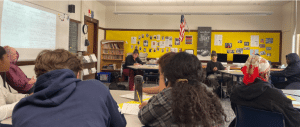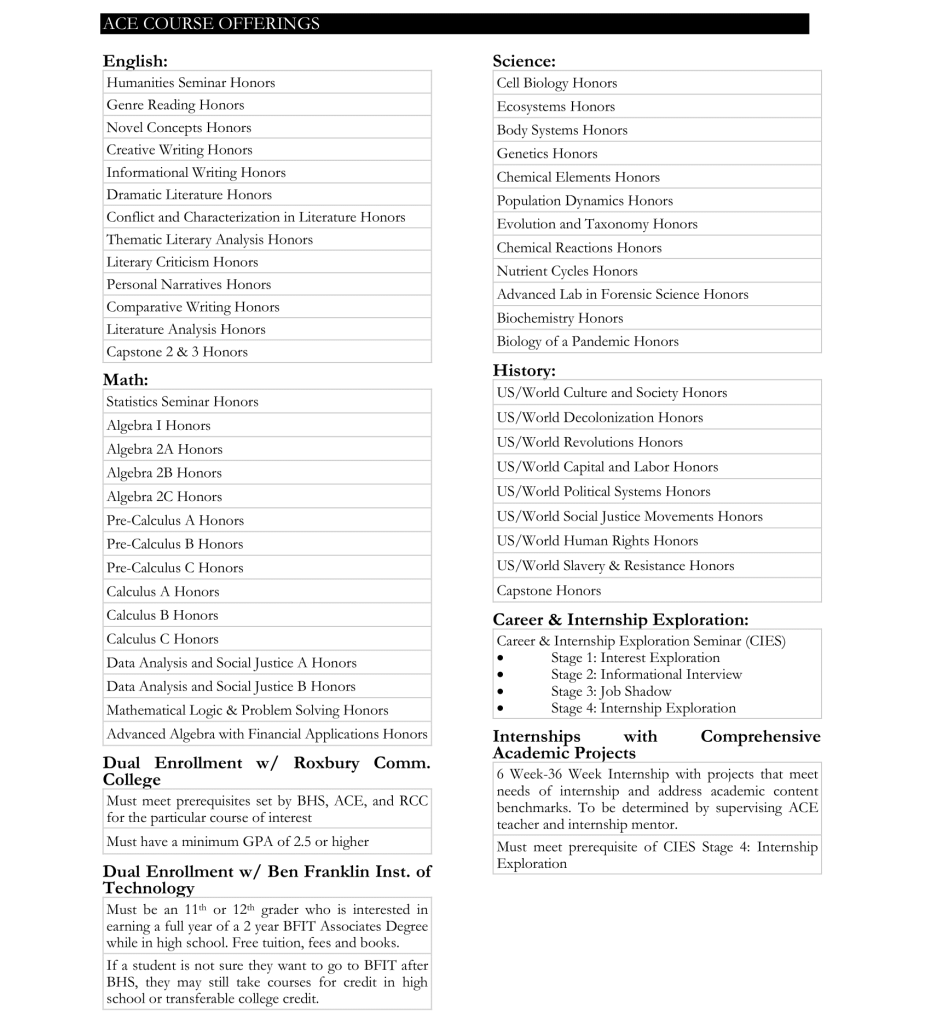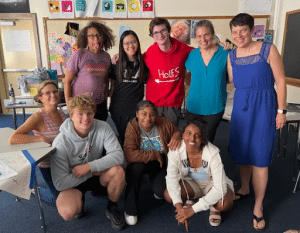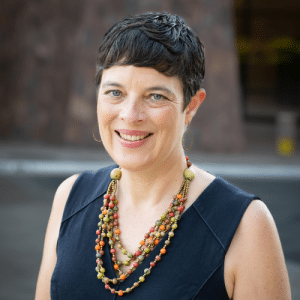The ACE CBE Model: Rethinking Curriculum for Depth and Engagement
CompetencyWorks Blog
This post delves into the competency-based academic model at the Alternative Choices in Education (ACE) Program at Brookline High School (BHS), which serves up to 55 students in grades 10-12. 
In 2015, the founding and current program coordinator, Amy Bayer, led the competency-based redesign of the ACE program. An earlier post about ACE focused on how ACE creates a culture where students are known and connected. Building on this sense of belonging, a foundation for lasting learning, and a key element of competency-based education (CBE), the ACE CBE model develops its learners’ intellectual curiosity and agency through a thematic curriculum. Elements of the ACE curriculum parallel some of the design features of the Building 21 studio model but instead done within a comprehensive high school rather than in a lab school setting.
Key Elements of the ACE Curriculum Structure
ACE students take their core academic courses within ACE and elective classes – such as physical education, world languages, and the arts – within the mainstream BHS. A key structural difference at ACE is that students take two core courses at a time in six-week cycles rather than courses that last a semester or an entire year. This allows courses to be thematic, relevant and focused on depth over breadth.
The six-week structure allows for the flexible placement of students based on their performance to date and learning needs, reflecting the competency-based learning principle of meeting students where they are in their learning. Rather than placing students in grade-level courses based on their age, ACE bases placement on a student’s assessed skill level and knowledge in each content area. Each course has identified, transparent benchmarks that students become competent in before moving to other courses. If a student doesn’t demonstrate competency by the end of the cycle, they do not fail but rather continue to revise or repeat the course the next time it is offered.
Courses feature performance-based assessments that require students to apply their knowledge and skills. Exhibitions happen twice yearly for sophomores and juniors and three times for seniors. Exhibitions create a time for students to reflect on their academic progress as well as their development of the ACE Habits of Success – self-awareness and reflection, goal setting, perseverance, curiosity, self-regulation, collaboration, and community-mindedness. The final senior exhibition features a senior capstone experience as a legacy project.
The ACE schedule also includes an Advisory time twice a week and an ACE Academic Achievement/Learning Center four times a week. Academic Achievement time allows students to practice skills and build on knowledge from class time during the school day when they can access their teachers to get feedback or additional support. An Introductory Seminar course for new students blends an orientation to ACE with a project about the science of well-being and culminates in a happiness project where students design and test their metrics for happiness and need for self-care with action research that includes a statistical component.
The ACE program still intersects with the larger system of BHS. The competency levels students see on progress reports from ACE ultimately get translated to traditional grades on students’ transcripts, though as an A, B, C, or In Progress, not as a D or F. ACE transcripts do list all of the ACE courses, which means that students have more courses listed than the mainstream model, and a one-page info sheet about the ACE program accompanies the transcript.

Three Distinguishing Features of the ACE Academic Model
Thematic 6-Week Courses Support Relevant and Engaging Inquiry
ACE’s thematic curriculum emphasizes relevance. Course projects aim to combine self-discovery and relationship-building among class members with deep learning of the academic content. In the Novel Concepts English course, students were collaborating in preparation for recording a podcast about the novel Everything Here is Beautiful by Mira T. Lee. In the Chemical Elements science course, students create a role-playing game elemental superhero – complete with defensive, attack, and special moves – all based on an in-depth study of the chemical properties of specific elements. They test their knowledge and skill in a highly celebrated tournament of elements. In the US/World Capital and Labor history course, students debated the relative merits of capitalism and communism. The mathematics offerings mostly look like traditional courses, but there is a focus on conceptual development. As one course cycle wrapped up, students presented their work and thinking related to a math investigation and peers who were familiar with the investigations asked questions and offered feedback. One student said that they were still “in progress” because they did the math with help, but couldn’t fully explain it. Offerings also include courses such as Data Science for Social Justice and Advanced Algebra with Financial Applications.
The ACE team built the course offerings from the Massachusetts state standards and a scan of related fields and careers. The core offerings remain relatively stable from year to year, though new courses – such as the Biology of Pandemics – have been added. Additionally, within a course, teachers have the autonomy to update the materials, learning experiences, and assessments while still aligning with the identified benchmarks. For example, the current history teacher regularly reviews high-demand career paths and college syllabi to evolve elements of her courses. The staff has recently worked to offer interdisciplinary work such as a climate change and justice course that combines environmental science and sociology.

Shorter Cycles Allow Focus Without Cumulative Challenges
In contrast to full and half-year courses in a typical high school program, ACE’s organization of the curriculum into six-week classes offers opportunities for fresh starts on a regular basis. When a student is struggling with a course topic, a classmate or a teacher, the team works to support that student. Additionally, it is helpful that every six weeks, the ACE course schedule changes, which means that the student will be in new courses, possibly with a different teacher, and with a different mix of ACE classmates. ACE is a small program, which means that students cannot fully avoid a teacher or classmate who they don’t click with, but the short cycle creates opportunities for new beginnings and space to step back at times. Having students for three years (for those who start ACE in grade 10), balanced with the structure of shorter courses, provides both a sense of belonging and being known and multiple opportunities to engage in learning.
Rigor and High Expectations Do Not Always Mean More
In a community that values high achievement and preparedness for college, ACE wants to communicate to students and families that its approach is both different AND rigorous. Being learner-centered does not mean lowering expectations. By knowing each student, ACE staff design their curriculum to tap each student’s strengths and offer ways to strengthen their weaker skill areas through the curriculum, which goes deeper into thematic topics. To ensure high standards for learning, in the initial years of ACE, staff members regularly collaborated on their assessment of learning by scoring student work together to calibrate rubrics, set expectations for benchmarks, and get feedback on assessments. Norming continues now in smaller groups or pairs or when new, shared benchmarks are developed. This both raises the standard of performance and goes hand in hand with the culture of knowing people, which allows teachers to support students to learn well and demonstrate that high standard.
ACE staff members intentionally choose to limit how much homework they expect students to complete. They hold high standards and are clear about the work that needs to be done, whether at home or school. The Academic Achievement period creates space during the day for students to do academic work. One student spoke about how ACE’s celebration of school-life balance allows him to reach his goals, noting, “I play three instruments, golf, and chess. I get to do those things at ACE because there is enough time and space to do the work and still have time to work on other passions.” 
Knowing that they operate within the larger educational culture of their town, the ACE team made a successful case to get an “honors” designation for all ACE classes. The effort emerged from feedback from students who were interested in going to ACE but remained reluctant because they worried about being perceived as not being academically strong and about the mathematical impact on weighted GPA (grade-point average) calculations, which could have an impact on college admissions decisions. In framing their case with the district, as outlined in the ACE Statement on Honors Course Designations, they argue, that:
- Leveling is inequitable and damaging to students.
- ACE Courses are unleveled, intellectually challenging, equitable, and effective.
- Opting out of BHS leveling is not an option.
- Until BHS delevels, all ACE courses will be designated as Honors.
ACE illustrates one approach to navigating the inequities of the education system that they are trying to address while striving not to inadvertently put students in a position of disadvantage.
Continuous Reflection and Improvement
The ACE community and culture shape and intersect with the learning process and outcomes both within classes and beyond. In addition to the calibration mentioned above, staff regularly collaborate on big-picture topics like how to improve the student competency benchmark tracker and individual student learning needs. Through a student leadership council and community meetings, students also share their ideas for building community and improving ACE.
Elevating the ACE Habits of Success is one example of a recent area of focus. A group of staff and students gathered for two days in summer guided by the essential question: How do the Habits of Success actively live in the day-to-day experience of ACE in a way that students own their growth over their time at ACE? The group worked to review and refine the Habits of Success and proposed ways to more fully integrate HOS into learning at ACE by creating a menu of options for teachers and students to access. The group created a template with HOS icons for students to capture progress in a cumulative HOS portfolio.
ACE offers a model for bringing together learner-centered principles. As one student reflected, “This place pushes me beyond what I think I am capable of and pushes me out of my comfort zone. Here at ACE, we are set up to push ourselves, you know what I’m saying?” Pushing for excellence within a supportive environment allows both students and adults to flourish.
Learn More
- Culture is the Foundation: Building Relationships and Community at ACE
- The Evolution of a Competency-Based Academic Model at Chelsea Opportunity Academy
- Learning in a Supportive Community at Clark Street Community School
 Laurie Gagnon is the CompetencyWorks Program Director at the Aurora Institute. She leads the work of sharing promising practices shaping the future of K-12 personalized, competency-based education (CBE). In 2023, Laurie had the opportunity to spend time with ACE staff and students during the school year and summer, including bringing a small group for a collaborative site visit last June.
Laurie Gagnon is the CompetencyWorks Program Director at the Aurora Institute. She leads the work of sharing promising practices shaping the future of K-12 personalized, competency-based education (CBE). In 2023, Laurie had the opportunity to spend time with ACE staff and students during the school year and summer, including bringing a small group for a collaborative site visit last June.